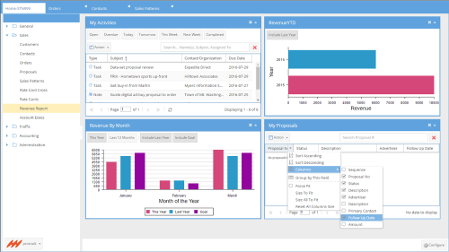Driving Way Beyond Traffic and Billing
SAN FRANCISCO—It’s been called one of the most difficult aspects of running a broadcast station, and it’s easy to see why.
The business of managing a station ranges from integrating sales to linear playout. And even at its simplest, there are rights issues to account for, constantly changing scheduling drop-ins to track, and finance target points to consider.
Now, add to that a need for today’s business management systems technology to be easy to use and simultaneously robust enough to handle the complexities of an individual station’s requirements.
“BMS systems are about to hit a major market shift,” said Lorne Brown, president of SintecMedia in New York. One of those reasons: the need to properly manage multiple new channels. Legacy systems that have traditionally specialized in linear TV ad or digital ad management must now switch gears. What’s needed today are simple yet flexible ways to control data and access information across multiple channels.
Using Myers PBS can centralize content metadata in a comprehensive database

Click on the Image to Enlarge
“TV and digital media are converging, advertisers want to buy using new metrics and audience data, and advertising is being distributed across new channels and platforms,” Brown said.
Get the TV Tech Newsletter
The professional video industry's #1 source for news, trends and product and tech information. Sign up below.
STREAMLINING IN THE CLOUD
Today’s current BMS systems are attempting to manage those key priorities. To do so, they are tackling the process in new ways—ways that streamline and provide a clear view of both business targets and the inventory at hand to ultimately unify and simplify the business of running a station.
Some solutions are finding a future rooted in the cloud. By taking the integration and synchronization of media operations into a virtualized cloud environment, broadcasters are able to take advantage of what the cloud does best: decrease cost and improve workflow efficiencies.
Imagine Communications took this step with Imagine xG Schedule, the company’s first cloud-based planning and scheduling system for linear, on-demand and digital platforms. When combined with other Imagine solutions, including the Versio cloud-native playout system and Unified Distribution portfolio, the solution is designed to be a cohesive workflow solution.
ProConsultant Informatique also took this step when it integrated its BMS LOUISE business management system with the Adways cloud-based platform—but in a unique way that pulls in a creative advertising component.
The Adways interactive video technology platform allows broadcasters to create and embed HTML5 interactive videos into creative content. The interactive video can be reviewed on any device, and each click is tracked—and fed back into BMS LOUISE—so broadcasters receive a dynamic report of points of interest and user engagement.
BMS LOUISE itself serves as the backbone to this new feature by providing a centralized management of media as well as technical, operational and business metadata.
FOLLOWING THE ‘CHAIN OF COMMAND’
Back on the ground, there’s another trend in business management systems, and that involves finding a tightly tailored solution that will allow a broadcaster to focus on what matters to an individual network or station.
For Army Television, the U.S. Army’s official audiovisual production organization, that focus included managing a wide variety of people, studios, facilities and equipment both within the Pentagon and in remote locations.
Talk about adhering to the “chain of command”—if the production team says it is unable to fulfill a request by a general to videotape an event, they better have a very specific reason why, said Kevin Beverley, Army Television engineering branch chief.
“It’s critical that we have a reliable scheduling system in place to make sure that we are utilizing our available resources to their maximum effectiveness at all times,” he said. In response to this need, the network installed a ScheduALL scheduling system from NetInsight to manage professional staff, work orders, as well as the use of production facilities and distribution of equipment.
Individual team members use the system in various ways: to see their assignment schedule in real time, or to determine how many events are scheduled in a given week, including all available staff, facilities and equipment.
Without such a system, “there is no way Army Television would be able to successfully achieve and maintain the operations tempo which has become our norm,” Beverley said. He estimates that scheduling system efficiencies result in up to 30 percent higher workload capability than the network could otherwise achieve. Customized solutions added to the ScheduALL system include project management, personnel manager, media manager and invoicing, among others.
The software is one such solution that gathers customizable features under the BMS umbrella; features like real-time conflict management, project management capabilities, integrated accounting tools and event-based notifications.
INTERNATIONAL FOCUS
Other BMS solutions are specifically looking at the best ways to address advertising placement across myriad multimedia delivery modes, including traditional broadcast, Web, new media and mobile. As campaigns become increasingly complex, so advertisers demand new levels of accountability.
The other key feature is optimizing use of inventory.

BSkyB worked with Imagine Communications to build an ad sales solution around the U.K. network’s Ad Smart initiative, a personalized TV advertising program that sends personalized ads to different households even though they are viewing the same programming.
That was the impetus behind BSkyB’s implementation of a Landmark Sales broadcast and multimedia sales solution: to maximize sales and operational efficiencies across 600 channels in 50 countries. The broadcaster worked with Imagine Communications to build an ad sales solution around BSkyB’s Ad Smart initiative, a personalized TV advertising program that sends personalized ads to different households even though they are viewing the same programming.
The solution has helped BSkyB address particular challenges, including core spot sales, and addressable advertising, the company said.
Gone are the days when just traffic, ads and billing were leading the charge. Today BMS systems are addressing personnel management, labor management, billing and receivables, external costs, media management, shipping — even down to managing bandwidth using new visual bandwidth calendars.
And for PBS, it meant using BMS to integrate a brand new channel altogether.
That’s what PBS faced this summer when it kicked off efforts to launch a new 24/7 PBS KIDS channel. This new service will air on more than 100 PBS stations via TV and live streaming by the end of 2017.
Preparations to coordinate programming and scheduling within the network’s existing infrastructure began months in advance of the launch, with PBS enlisting the ProTrack broadcast management system from Myers to download schedule and program metadata directly into PBS’s existing scheduling environment.
According to Crist Myers, president and CEO of Myers, this allowed the stations to focus resources on other important aspects of the project, like taking advantage of localization opportunities prior to playout.
With ProTrack, PBS can centralize content metadata in a comprehensive database, Myers said. By standardizing metadata and its usage, media facilities can streamline distribution workflows and improve operational transparency.
Like the majority of today’s BMS systems, it supports a variety of distribution types, workflows and formats, can be expanded via add-on modules that extend ProTrack's capabilities.
Broadcasters are also pressed to contend with scheduling for multiple outlets. That was a priority for SintecMedia during the development of its traffic and revenue management products—including OnAir, IBMS and Broadway—which are designed to manage traffic and sales operations across properties and media platforms with a single system.
Broadcasters like Fox, however, are bundling features beyond just simple traffic and billing. “OnBoard can allow [Fox] to package and sell audiences, as well as our basic content, more effectively and efficiently,” said Dan Callahan, vice president of programmatic sales.
For other broadcasters, the priority is to install business management systems that can tie together all inventory into a single transparent portal. OnAir helped NBC bring together all of its broadcast and cable inventory tech stacks, which helped the Peacock Network operate more on a portfolio level, said Sheelpa Patel, senior vice president of sales solutions for NBC Universal. “[This] allows us to be able to look at all of our inventory across the portfolio in one single solution,” she said.
This type of control allows NBC to enable emerging sales strategies as well as help enable new operational efficiencies, she added.
Susan Ashworth is the former editor of TV Technology. In addition to her work covering the broadcast television industry, she has served as editor of two housing finance magazines and written about topics as varied as education, radio, chess, music and sports. Outside of her life as a writer, she recently served as president of a local nonprofit organization supporting girls in baseball.

